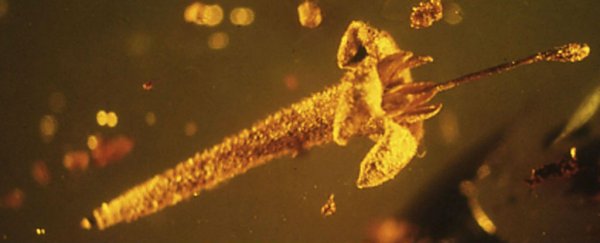In a move straight out of Jurassic Park, researchers in the US report the discovery of a never-before-seen species of flower, Strychnos electri, trapped inside a piece of 15-million-year-old amber that sat in storage for over 30 years.
The discovery came when botanist Lena Struwe from Rutgers University found the flower inside a piece of amber that was originally brought to the lab back in 1986 when entomologist George Poinar, well-known for his work with amber, returned with other 500 fossils from an amber mine in the Dominican Republic.
"The specimens are beautiful, perfectly preserved fossil flowers, which at one point in time were borne by plants that lived in a steamy tropical forest with both large and small trees, climbing vines, palms, grasses and other vegetation," said Poinar, whose earlier work inspired the original Jurassic Park novel.
First off, what exactly is amber? Despite what it looks like, amber is formed from tree resin, not sap. You can think of sap as tree blood that flows in a vascular system, and resin, on the other hand, forms on the outer layers of the tree where it drips off and eventually hardens. If you've ever touched a pine tree, you've likely experienced resin in all of its annoyingly sticky wonder.
Since his initial trip, Poinar has been busy studying ancient insect specimens that are usually found intact inside pieces of amber. He was shocked to discover a fully intact flower inside one of the amber fossils - an ultra-rare sight that prompted him to call in Struwe, an expert in the genus Strychnos, to confirm it.
 Rutgers University
Rutgers University
"The characters mostly used to identify species of Strychnos are flower morphology, and that's what we luckily have for this fossil," Struwe says. "I looked at each specimen of New World species, photographed and measured it, and compared it to the photo George sent me. I asked myself, 'How do the hairs on the petals look?' 'Where are the hairs situated?' and so on."
After comparing the specimen to the 200 known species with the genus Strychnos, a process that involved studying high resolution photos and dried specimen at a bunch of different institutes, Struwe announced that the fossil was, in fact, a new species, which she dubbed Strychnos electri because "elektron" means "amber" in Greek.
The genus harbours some of the world's most famous poisons, including strychnine and curare - poisons that have been used in blow-gun weapons, rat control, Sherlock Holmes stories and the movie, Psycho.
According to Struwe, the new species will allow researchers to better understand how plants evolved in the Caribbean and New World. Also, the fact that it was found in Poinar's 30-year-old amber collection hints that there are many species to still find and examine. The hope is that more species will emerge so that researchers can get a better understanding of the world's plants.
The team's full report was published in Nature Plants.
